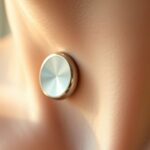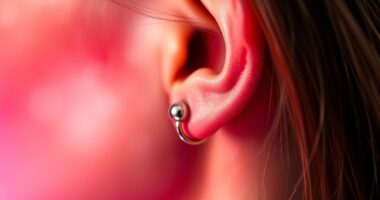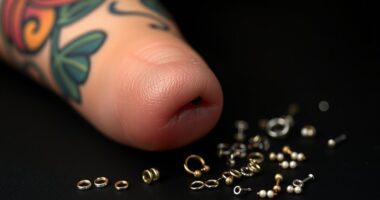Body modification includes techniques like tattooing, scarification, and implants that often involve complex procedures and cultural meanings, sometimes taking longer to heal. Piercings are simpler, quicker, and usually less invasive, serving mainly as self-expression or fashion. Both carry health risks if not done properly, but they differ in purpose and significance. If you want to explore how these practices compare across different cultures and personal choices, there’s more to discover below.
Key Takeaways
- Body modification includes complex procedures like scarification and implants, often requiring surgical techniques, while piercing involves simpler, temporary openings.
- Both practices carry health risks such as infection and allergic reactions, emphasizing the need for proper care and skilled practitioners.
- Cultural significance varies: modifications may symbolize identity or rites of passage, whereas piercings are often a form of self-expression.
- Healing times differ: piercings typically heal faster, while body modifications involve longer, more involved recovery processes.
- Personal and cultural factors influence the choice, with modifications being more personalized or culturally meaningful than standard piercings.

Body modification and piercing are often used interchangeably, but they represent two distinct practices with different scopes and intentions. When you think about body modification, you’re looking at a broad spectrum of techniques that alter your body’s appearance permanently or semi-permanently. These modifications often carry cultural significance, reflecting identity, social status, or spiritual beliefs within various communities. For example, some cultures use scarification or tattooing to mark rites of passage, while others might incorporate implants or subdermal modifications to symbolize tribal affiliation. Piercing, on the other hand, generally involves creating small openings in the skin for jewelry placement. It’s usually a more temporary or less invasive form of body alteration, often driven by personal style or aesthetic preferences rather than deep-rooted cultural meanings.
While both practices can be deeply meaningful, body modification tends to involve more extensive procedures, sometimes requiring surgical techniques or long healing times. These modifications can be highly personalized, with many choosing to work with skilled practitioners who specialize in complex alterations. Piercings are typically quicker to perform and heal faster, but they still come with health risks if not done carefully. You must be aware that improper piercing techniques or unsterile equipment can introduce infections, cause allergic reactions to certain metals, or result in nerve damage. Whether you’re considering a large-scale modification or a simple piercing, understanding the health risks involved is essential for making informed choices.
Body modification involves complex procedures with longer healing; piercings are quicker but still carry health risks.
Cultural significance plays a substantial role in how body modifications are perceived and accepted across different societies. In some cultures, body modifications symbolize maturity, bravery, or spiritual enlightenment. For instance, certain tribes use face tattoos or scarification as rites of passage, which are respected and celebrated within their communities. Conversely, in Western societies, piercings often serve as a form of self-expression or fashion statement, with less emphasis on tradition and more on individual identity. Recognizing these cultural dimensions helps you appreciate the profound meanings behind different body alterations and why they matter to the people who choose to undergo them.
Ultimately, whether you’re exploring body modification or piercing, it’s vital to weigh the cultural implications and health risks involved. Proper research, choosing experienced professionals, and understanding your own motivations can ensure that your body alteration experience is safe, respectful, and aligned with your personal values. Remember, these practices aren’t just about aesthetics—they’re often deeply personal or culturally significant choices that deserve thoughtful consideration.
Frequently Asked Questions
How Long Does Body Modification Typically Take to Heal?
Body modification healing times vary, but generally, you’ll see initial recovery in 2-4 weeks. Deep or extensive procedures may take several months for full healing. During this healing timeline, follow recovery tips like keeping the area clean, avoiding irritants, and not rushing the process. Listen to your body and consult your specialist if you notice signs of infection or prolonged discomfort to guarantee proper healing.
Are There Age Restrictions for Body Modification Procedures?
Imagine standing at a vibrant carnival, enthusiastic to try a daring ride—your age matters. For body modification, age restrictions vary by location, often requiring you to be at least 18, or 16 with parental consent. These rules protect your growing body, ensuring you’re ready for the transformation. So, check local laws and discuss with a parent or guardian to make sure your exciting body art journey is safe and legal.
What Are the Risks Associated With Non-Professional Body Modifications?
You risk serious health issues with DIY body modifications. Without professional skills, you could face infection risks from improper technique and unsterile tools. DIY dangers include excessive bleeding, nerve damage, and permanent scarring. You might also use incorrect materials, which can cause allergic reactions or rejection. Overall, attempting body modifications yourself considerably increases the chance of complications, so it’s best to seek trained professionals to ensure safety and proper healing.
How Can I Find a Reputable Body Modification Artist?
You can find a reputable body modification artist by checking their credentials and ensuring their studio is spotless. Imagine walking into a clean, professional space where safety is a top priority, giving you peace of mind. Look for artist credentials on their website or social media, and read reviews from previous clients. A trustworthy artist maintains high studio cleanliness standards, uses sterile equipment, and openly discusses safety procedures to protect your health.
Do Body Modifications Affect Future Medical Treatments or Scans?
Body modifications can affect future medical treatments or scans, especially during medical imaging like MRI, CT, or X-rays. Metal or other materials used in modifications might interfere with image quality or cause discomfort. Additionally, some modifications could increase the risk of surgical complications if surgery is needed. Always inform your healthcare provider about your body modifications beforehand so they can take necessary precautions and avoid potential issues.
Conclusion
Ultimately, understanding body modification and piercing helps you make mindful choices. By distinguishing between bold body alterations and playful piercings, you’ll better appreciate their purpose and permanence. Remember, whether you’re considering a subtle stud or a striking sculpture, safety and self-expression shape your decisions. So, approach body changes with curiosity, care, and confidence, crafting a personal canvas that communicates your unique story. Embrace your evolution, and enjoy exploring your expressive, exciting journey ahead.
Piecing together a life one day at a time, that’s me. I’m Rusty, and I love being editor-in-chief of creative piercing. It’s my passion to help others see their vision and bring it to life. When I’m not working or taking care of my family, you can find me reading a good book or eating pie (of course!).

















